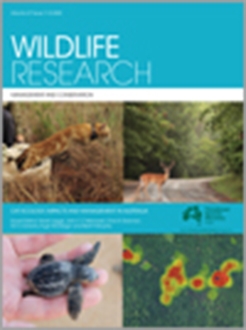Context. Helicopter darting has been used to capture wild deer, but this method has never been used for chital deer (Axis axis).
Aim.. The aims of this study were to develop, assess and refine a helicopter darting technique for wild chital deer in northern Australia by quantifying: (1) reliable pharmacological doses for immobilisation; (2) the efficacy of the technique (including the duration of procedures); and (3) the frequency of adverse animal welfare events.
Methods.. The study was conducted in three stages: an initial protocol (n = 25 deer captured) in July−August 2018; a refined second protocol implemented in June 2019 (n = 12 deer captured); and a further refined third protocol implemented in June 2019 (n = 12 deer captured). Parameters to estimate the duration of procedures were measured and the frequency of several adverse animal welfare events during capture were quantified: mortality (at the time of capture and within 14 days of capture), hyperthermia, hypoxaemia, dart inaccuracy and manual restraint. Finally, GPS location collars with a mortality-sensing function were used to monitor post-release mortality.
Results. Mortality within 14 days of capture was 40% for the first stage, 25% for the second stage and 17% for the third stage. Considerable refinement of procedures occurred between stages in consultation with an Animal Ethics Committee. One-third of all 15 mortalities occurred at the time of capture and were attributed to ballistic trauma from dart impact and acute capture myopathy. The majority (n = 10) of mortalities, however, occurred post-release and were only detected by mortality-sensing GPS location collars. These post-release mortalities were attributed to capture myopathy.
Conclusions. Helicopter darting of wild chital deer poses animal welfare risks, but these can be minimised through the selection of the most appropriate pharmacological agents and attempts at preventing factors such as hyperthermia and hypoxaemia that contribute to the development of capture myopathy. Further research into capture protocols is needed for helicopter-based immobilisation of chital deer. Fitting animals with GPS location collars enabled post-release mortality, which was significant, to be evaluated.






